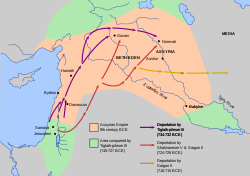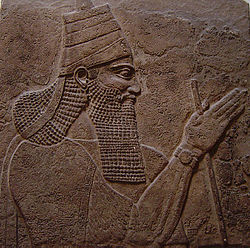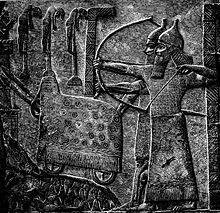- Tiglath-Pileser III
-
Tiglath-Pileser III (from the Hebraic form[1] of Akkadian: Tukultī-apil-Ešarra, "my trust is in the son of Esharra") was a prominent king of Assyria in the eighth century BC (ruled 745–727 BC)[2][3] and is widely regarded as the founder of the Neo-Assyrian Empire.[4] [5]
Tiglath-Pileser III seized the Assyrian throne during a civil war and killed the royal family. He made sweeping changes to the Assyrian government, considerably improving its efficiency and security. Assyrian forces became a standing army. Tiglath-Pileser III subjected Babylonia to tribute, severely punished Urartu (Armenia), and defeated the Medes and the Hittites. He reconquered Syria (destroying Damascus) and the Mediterranean seaports of Phoenicia. Tiglath-Pileser III also occupied Philistia and Israel. Later in his reign, Tiglath-Pileser III assumed total control of Babylonia.
Tiglath-Pileser III discouraged revolts against Assyrian rule, with the use of forced deportations of thousands of people all over the empire. He is considered to be one of the most successful military commanders in world history, conquering most of the world known to the Assyrians before his death.
Contents
Origins
Former governor of Kalhu[6] and a general, Pulu was a usurper who assumed his Assyrian throne name from two more legitimate predecessors. He described himself as a son of Adad-nirari III in his inscriptions, but it is uncertain if this is truthful. He seized the throne in the midst of civil war on 13 Ayaru, 745 BC.[7][8] As a result of Pulu seizing the throne in a bloody coup d'état, the royal family was slaughtered,[9] and Assyria was set on the path to empire in order to ensure the survival of the kingdom.[10]
Reign
Assyrian power in the Near East greatly increased as the result of Tiglath-Pileser's military reforms (see "Reforms" below) and his campaigns of conquest. Upon ascending the throne, he claimed (in Annal 9, which dates to 745 BC, his first regnal year) to have annexed Babylonia, from "Dur-(Kuri)galzu, Sippar of Shamash, ... the cities [of Ba]bylonia up to the Uqnu river [by the shore of the Lo]wer [Sea]"[11] (which referred to the Persian Gulf), and subsequently placed his eunuch over them as governor. Also in his first year of reign he defeated the powerful kingdom of Urartu (in modern Armenia), whose hegemony under the rulership of Sarduri II had extended to Asia Minor, northern Mesopotamia,western Iran and Syria; there he found unrivalled horses for his war-chariots.[12] He also defeated the Medes before making war on and conquering the Neo-Hittites, Syria and Phoenicia. He took Arpad in 740 BC after three years of siege, annexed it as a province (over which he placed one of his eunuchs as governors), and subjected Hamath to tribute. Assyrian inscriptions record in 740 BC, the fifth year of his reign, a victory over Azariah (Uzziah), king of Judah, whose achievements are described in 2 Chronicles 26.He also subjugated Damascus, the Arabs under Queen Zabibe, Menahem of Israel and Sam'al's king Azriyau, who all paid him tribute.[citation needed] In 737 and 736 BC he turned his attention again to Iran, conquering the Medes and Persians and occupying a large part of Iran.[citation needed] According to the royal inscriptions of Tiglath-Pileser many of the inhabitants were enslaved and deported to other parts of the Assyrian empire, as commonly done by his predecessors. At sieges captives were slaughtered and their bodies raised on stakes and displayed before the city (illustration, right).
In October 729 BC , Tiglath-Pileser assumed total control of Babylon, capturing the Babylonian king Nabu-mukin-zeri (ABC 1 Col.1:21) and having himself crowned as "King Pulu of Babylon".
Biblical records
 Map showing Tiglath's conquests (green) and deportation of Israelites. Tiglath-Pileser III discouraged revolts against Assyrian rule, with the use of forced deportations of thousands of people all over the empire.[13]
Map showing Tiglath's conquests (green) and deportation of Israelites. Tiglath-Pileser III discouraged revolts against Assyrian rule, with the use of forced deportations of thousands of people all over the empire.[13]
Biblical records, corroborated by Assyrian ones, describe how Tiglath-Pileser III exacted 1000 talents of silver tribute from King Menahem of Israel (2 Kings 15:19) and defeated his successor Pekah (15:29). Pekah had allied with Rezin, king of the Arameans against Ahaz (known to the Assyrians as Yahu-khazi), king of Judah, who responded by appealing for the Assyrian monarch's help with the Temple gold and silver. Tiglath-Pileser complied by seizing Damascus, executing Rezin, and deporting the Aramaean inhabitants to Kir (16:9). He also seized the northern half of Israel, and deported the Reubenites, Gadites, and Manasseh to Halah, Habor, Hara, and the Gozan river (1 Chron. 5:26). Beyond this, the alliance was not beneficial to Ahaz. (2 Chron 28:20).
Reforms
Upon ascending the throne, Tiglath-Pileser instituted several reforms to different sectors of the Assyrian state, which arguably revived Assyria's hegemony over the Near East.
The first of such reforms entailed thwarting the powers of the high Assyrian officials, which during the reigns of his predecessors had become excessive. Officials such as Šamši-ilu, who was turtanu and a prominent official since the time of Adad-Nirari III, often led their own campaigns and erected their own commemorative stelae, often without mentioning the king at all.[14] Since his earliest inscriptions (and thus from the beginning of his reign), he gave regular mention of appointing eunuchs as governors of (newly conquered) provinces; this removed the threat of provincial rule becoming a dynastic matter. He also sought to reduce the power of his officials by reducing the size of the provinces (in some cases the northern provinces were increased to include newly conquered territories), thus decreasing their resources, should they have desired to incite a revolt. Subsequently, there were more provinces, more governors (most of which were eunuchs), and less power per governor.
The second reform targeted the army. Instead of a largely native Assyrian army which normally campaigned only in the summer time, Tiglath-Pileser incorporated large numbers of conquered people into the army, thus adding a substantial foreign element. This force mainly comprised the infantry, whereas the native Assyrians comprised the cavalry and chariotry. As a result of Tiglath-Pileser's military reforms, the Assyrian Empire was armed with a greatly expanded army which could campaign throughout the year. The addition of the cavalry and the chariot contingents to the army was mostly due to the steppe cultures lurking nearby to the north, which sometimes invaded their northern lands, using mainly cavalry and primitive chariots.
Legacy
Tiglath-Pileser III's conquests and reforms led to the establishment of the Neo-Assyrian Kingdom as a true empire. He built a royal palace in Nimrud (the so-called "central palace"), later dismantled by Esarhaddon. He had his royal annals engraved across the bas-reliefs depicting his military achievements on the sculptured slabs decorating his palace.
On his death he was succeeded by his son Ululayu, who took the name Shalmaneser V and further campaigned in the Levant, and captured Samaria.
See also
- Kings of Assyria
- Syro-Ephraimite War
Footnotes
- ^ Spelled as "Tiglath-Pileser" in the Book of Kings (2Kings 15:29) and as "Tilgath-Pilneser" in the Book of Chronicles (2Chronicles 28:20).
- ^ Assyrian Eponym List
- ^ Tadmor, Inscriptions, p. 29.
- ^ Healy, Assyrians, p. 17
- ^ history of Mesopotamia :: The Neo-Assyrian Empire (746-609) - Britannica Online Encyclopedia
- ^ Healy, Assyrians, p. 17
- ^ 11th edition of the Encyclopædia Britannica, 1911 [1]
- ^ [2]
- ^ Healy, Assyrians, p. 17
- ^ Healy, Assyrians, p. 17
- ^ Tadmor, Inscriptions, p. 43.
- ^ Luckenbill, Ancient Records, vol II, p. 84.
- ^ Healy, pp. 21
- ^ Shafer, A.T. (1998). The Carving of an Empire: Neo-Assyrian Monuments on the Periphery, p.32-33
References
- Healy, Mark (1991). The Ancient Assyrians. London: Osprey. ISBN 1855321637. OCLC 26351868. http://books.google.com/books?id=Hodh6fgx-DMC&printsec=frontcover&dq=isbn=1855321637.
- Luckenbill, D. D. Ancient Records of Assyria and Babylonia, vol II, (Chicago, 1927).
- Saggs, H. The Might that was Assyria (London, 1984).
- Tadmor, Hayim, The inscriptions of Tiglath-pileser III, King of Assyria: critical edition, with introductions, translations, and commentary (Jerusalem, Israel Academy of Sciences and Humanities, 1994).
- Yehuda Kaplan, "Recruitment of Foreign Soldiers into the Neo-Assyrian Army during the Reign of Tiglath-pileser III," in Mordechai Cogan and Dan`el Kahn (eds), Treasures on Camels' Humps: Historical and Literary Studies from the Ancient Near East Presented to Israel Eph'al (Jerusalem, Magnes Press, 2008),
Preceded by
Ashur-nirari VKing of Assyria
745 – 727 BCSucceeded by
Shalmaneser VPreceded by
Nabu-mukin-zeriKing of Babylon
729 – 727 BCCategories:- 727 BC deaths
- Assyrian kings
- Babylonian kings
- Monarchs of the Hebrew Bible
Wikimedia Foundation. 2010.


